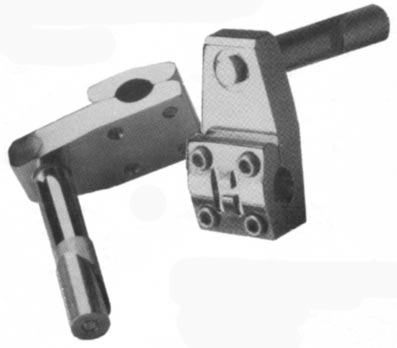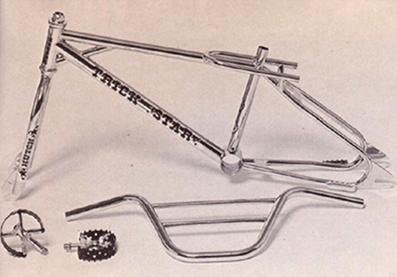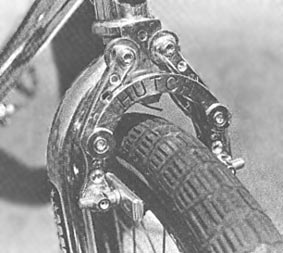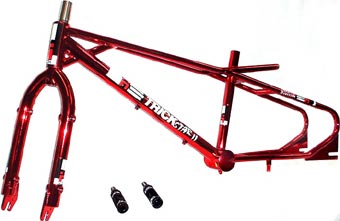Special 1983 Winter Edition of Super BMX: Rich's first activity other than the bike shop was a mail order business. They sold BMX equipment produced by many different manufacturers through the mail. To help promote the mail-order business Rich put together a bike shop team. The team as well as the mail order business were so successful that Hutchins decided to produce a product of his own. During the fall of 1980 Rich introduced the Hutch frame and fork, which he equipped on his bike shop team. Hutchins' first big name rider was Rich Farside, who he decided to sponsor at the same time the frame/ fork became available. Towards the end of 1980 sales of the Hutch frame and fork were exceeding expectations and therefore Hutch began looking for additional national caliber riders. At the 1980 World Championship held in Indianapolis Tim Judge won the trophy dash and named World Champion. Rich approached Tim, offering a sponsorship, which he accepted three months later. At this point the Hutch team consisted of Rich Farside and Tim Judge, but Hutchins felt he was missing something - - a professional racer to compete on his frame and fork combo. Hutch offered the position to Toby Henderson two months after Timmy was put on board, who also accepted.
Special 1983 Winter Edition of Super BMX: The remainder of the Hutch team was added during the fall of 1981, and as a group still remain mostly intact. Today the Hutch team consists of: Toby Henderson, pro; Tim Judge, pro; Charlie Williams. 17 expert; Greg Liggins, 15; Steve Veltman, 14 expert; Jason Griggs, 13 expert: Monte Gray, 12 expert: Brad Moore. 9 expert; Jason Kelly, 7 expert and Missy Fred, 9 girl.
PEDALS.
Ad in BMX Action september 1982: Competition non-slip aluminium sealed bearings with chromoly shaft, chrome like finish. 9/16" and 1/2".
HUBS.
Ad in BMX Action september 1982: Superlite, superstrong 100% magnesium, sealed bearings with titanium axles, flip-flop rear, 11 1/2 ounces (both hubs) half the weight of other hubs and twice as strong! These are Pro racer hubs but can still be used on mini setups. Silver only.


Ad in BMX Action january 1984: The longer length is great for quick hole shots; it will lengthen shorter frames to keep from knocking your knees on the handlebars, and also provide easy speed jumping and quicker cornering. A Valuable Necessity for All Racers The Ultimate In Racing Equipment Today, Using the Finest in Aluminum and Chromoly. Chrome plated. Engraved H. Long, strong, lite, dynamic.
TEAM ADDITIONS.
Hutch entered the freestyle marketplace in 1983, when it cosponsored Mike Buff to ride its frames. Soon after that, they started talking to a new but rapidly growing name on the freestyle scene -Woody Itson.
BMX Plus! february 1984: Hutch recently announced the signing of four new members to his factory team. Two are racers - Christine Anderson (who just finished the year as National Number One 10-11 Girl in the NBL) and Jason Johnson, 11 (who was the big star of Schwinn's racing efforts in the younger divisions): two are freestylists - Woody itson (who will continue to ride with the Vans Trick Team) and Mike Buff (who will continue to ride with the BMX Action Trick Team).
HUTCH PLANT.
Special 1983 Winter Edition of Super BMX: Today, the equipment at the Hutch plant includes such state of the art machinery as pneumatic air operated cylinder type jigs. Before these the jigs were all operated by hand. Automatic tube polishing machines, automatic programmable tube benders and CNC computer operated lathe machines. The automatic jigs are used to produce things like forks, handlebars and crank arms. Forks, handlebars and seat posts are produced using the automatic tube benders. The CNC computerized lathe is a very useful tool; it is used to help make hubs, forks, cranks, pedals, seat post clamps and headset locks. While the tube polishing machines are used on every product that Hutch makes. In three short years, Rich Hutch ins has turned a bike shop into one of the busiest manufacturing facilities dedicated solely to producing bicycle motocross equipment. In addition, the Hutch factory is one of the most modem: the CNC computer operated lathe uses robotics and at this time is one of only four such machines operating in the United States. Quality is a watch word associated with everything named "Hutch," from a single Hutch seat post clamp all the way to the computerized machine that helps produce it.

Tested in BMX Plus! january 1985.
Steve Rainey, may 2007: (...) The bike was designed and built after experimenting with many different ideas of the actual employees at the Hutch company, namely Bill Grove, Jeff Peck and Steve Rainey to name a few. We did have the prototypes ridden by some of the riders, including Woody, for their input on the modifications (...)
Woody Itson, august 2011: Here is how the Trick Star came to be: Hutch gave me a pro racer to ride and asked me what I would do to change it. I told him the first thing was to steepen the head tube angle and told them to what degree (75). Second we needed to add a standing platform, third was standing platforms on the rear chain stays, and finally to add foot clearance between the front tire and the down tube. The first one (standing platform) they gave me and buff to test on the first prototype frame was lame, ugly, and useless. Second I told them them the size and location of the rear standers on the chain stays. The first versions they made was bad (way to big and looked ridiculous) and I told them that wouldn't work. The second version was also bad (smaller but still square-and got in the way of your feet) and I told them what to do. The third version on those was correct. I told them to add a coaster brake bridge to back end, the engineers at Hutch did come up with their way of doing that and it came out really cool. But Buff and I pushed hard for that because we both ran coasters. Finally the foot clearance issue on the front end. Again, I told them what to do with moving the down tube up to the top tube area for clearance, but someone there came up with the tube piercing the down tube and attaching to the top tube.
The best way to explain it is like this. If you look at the first prototype type frames me and Buff rode, that's what "they came up with" and I was bummed with it and told Hutch that's not what I asked for. When you see the production version of the Trick Star, that's what I came up with with the help of an engineer at Hutch. I spent a lot of time on the phone with people at Hutch and flew out there almost once a month in the early years. I also came up with the name Trick Star. That is how it went down. If you check all the earliest photo's from the earliest magazines it backs up what I'm saying 100%. The engineers I dealt with at Hutch were great people and very supportive and without them there would have been no Trick Star. However, without me, you wouldn't have the Trick Star you know today.

Hutch 1985 Freestyle Tour with Woody Itson, Donovan Ritter and Mike Dominguez.
HUTCH WINDSTYLER.
Made in Taiwan. Tested in Freestylin january 1986.
The frames weighs 2 pounds 3 ounces.A l'occasion du salon de Long Beach en début d'année, Rick Hutchins fait faire un vélo plaqué or. C'est Woody Itson (rider, team manager et responsable de développement du Trick Star) qui en héritera.
Hutch is making skateboards.
Hutch 1986 Freestyle Tour with Woody Itson and Donovan Ritter. Rick Moliterno will be doing some shows.
HUTCH WOODY BRAKE AND FORK.
There is no visible brake cable. Everything's tucked away inside the forks.
Woody Itson, august 2011: There was also a frame designed with the same basic type of set up, but it never went into production.
Fall 1986, Hutch had financial difficulties and dropped their team.

Hutch Trickstar II Frame & Fork circa 1987. Candy Apple Red, Candy Apple Blue, White or Chrome. Comes with fork pegs.
Woody Itson, august 2011: The Trick Star 2 came after I was gone from Hutch.
TAIWAN.
Bicross Magazine mars 1987: Monsieur Hutchins a enfin compris qu'il n'était plus possible de produire des bx aux Etats-Unis, les coûts étant trop élevés. Il fait désormais fabriquer presque comme tout le monde, à Taïwan.
NEW OWNER.
Bicross Magazine juillet 1987: Hutch est en partie racheté par un grand distributeur de Louisville. Rick Hutchins reste patron exécutif. Les team de free et de course sont dissous.
BMX Action july 1987: Hutch has been sold... or been bought, depending on which way you look at it. The new owner is William Bellis, Sr.,a very well-off businessman who flies all over the U.S. in his personal Lear jet and owns 25 different companies -some of them bicycle related. Richard Hutchins, who will still be running the company, says Bellis has owned Louisville Cycle for quite a while and just purchased Columbus Cycles last year. Hutch (the company) is now considered to be a division of Columbus Cycle, having distribution centers in Columbus, Ohio, Atlanta, Georgia, Chicago, Illinois, and now... Baltimore, Maryland. Hutch describes the deal as being «Good for us, good for them, and good for everyone.» He also says that what is going on with the BMX industry right now is simular to what happened in the car industry. «People have always bought their competition. Pretty soon, I'd expect to see five major manufacturers.» So far, that seems to be the way the things are going -Service Cycle bought Mongoose, West Coast bought Haro, Seattle Bike Supply worked out a deal with Red Line, and now Columbus Cycle purchases Hutch. What'll be next ?
Bob Morales designed bike, uniforms and graphics.


Frame and fork with every tube is 100% chromoly. Hutch Dually bars. Hutch pro stem. Sealed 48 wheeels. Hutch freestyle tires.

Jay Becht, BMX Plus! may 1992: A man in town, Bill Bellis, purchased Hutchins/Revcore from Richard Hutchins and Roger Worsham. He then relocated both companies to Louisville, Kentucky. He had other businesses and not much time to run Hutchins/Revcore so he was looking for someone to help him out. I applied and got the job. I was in charge of management, sales, promotion and design. Mr. Bellis then sold the company to two other people. It turned out that they couldn't handle it so he took it back. He then offered it to Mike and myself in February of '91, right before the ABA WinterNationals last year. I know this was a good opportunity. The price was definitely one of the factors; besides, I've always wanted to own and run a bike company. Another reason is that I love BMX (I've raced since '82 and I've been a pro since '87. ) and I'm always trying to make it bigger. I think Hutchins/Revcore will make a difference in the future.
Randy Bowser team manager 1985
Mike Buff december 1983 - ....
Brian Dean BMX Action june 1984: Hutch has just added a pro skatepark looney, Brian Dean, to the Hutch factory squad.
Mike Dominguez 1985 only
Woody Itson december 1983 - fall 1986. Designed Hutch Trick Star.Team manager in 1986.
Woody Itson, august 2011: I was the first Freestyle rider to sign with Hutch. Everette Rosecrans at Vans is the person who put me and Hutch together. The second rider was Mike Buff. There were no other rider at that time until I got Mike Dominguez on the team.
Dennis Langlais (1988 - ....)
Rick Moliterno In 1985 Woody Itson asked Hutch to "hook me up" with a frame and fork, and they did. - fall 1986.
Chris Pott (1988 - ....)
Donovan Riter Freestylin july 1985: Donovan Ritter was released from Haro and almost instantly picked up by Hutch.
José Yanez 1985 - ....